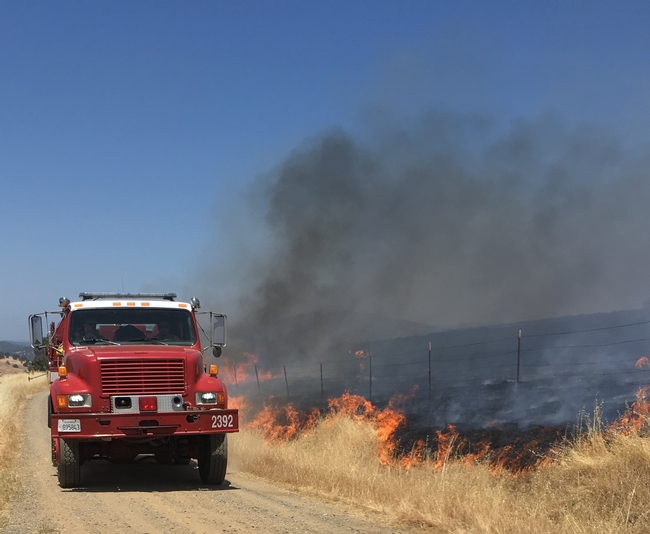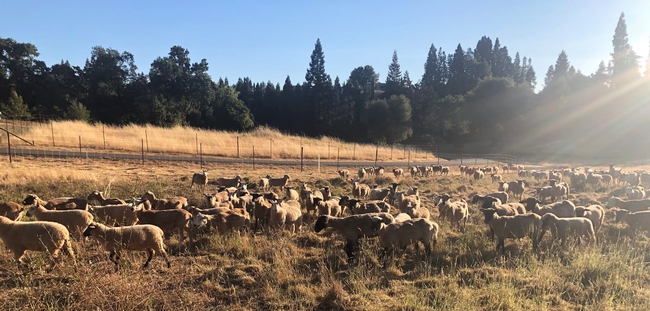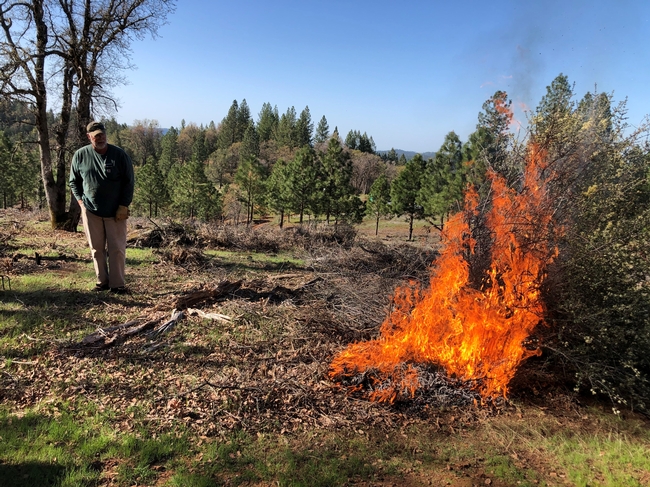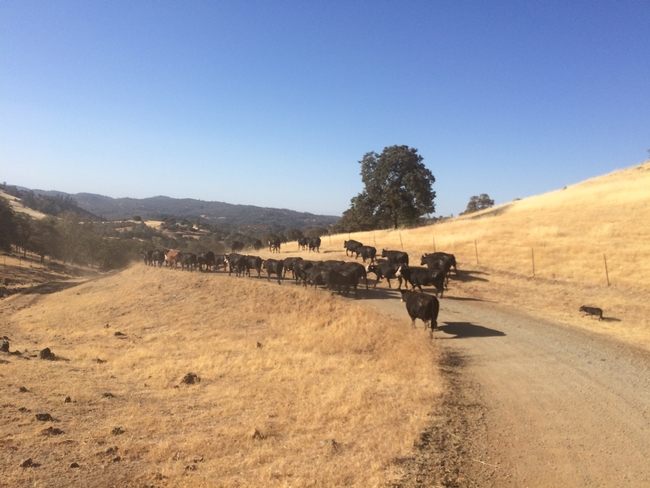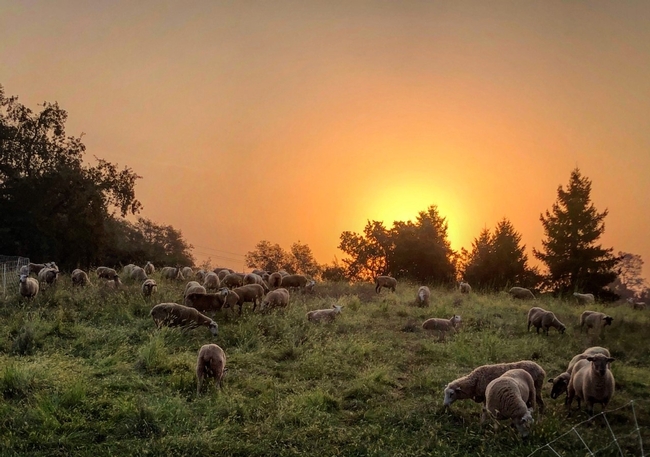- Author: Dan Macon
With wildfire season in full swing in California and elsewhere in the West, many ranchers are increasingly concerned about the safety and well-being of their livestock. Many - if not most - commercial-scale producers in the Sierra foothills and higher elevations operate on multiple parcels with multiple landowners. Accessing livestock in an area under evacuation orders due to wildfire - or any other large-scale disaster, for that matter - can be problematic. Commercial-scale operations typically have more animals than can be evacuated in a single load, making sheltering-in-place the only viable option. But livestock that are sheltered-in-place need care - water, feed, medical attention, etc. - making access for ranchers critical.
Over the last 6 months, I've been working with a committee of ranchers from Placer, Nevada, and Yuba Counties, along with the Agricultural Commissioners from each county, to create a Disaster Livestock Access Pass Program. The geographic focus of this effort mirrors CalFire's administrative region - and reflects the on-the-ground reality that many ranching operations cross county boundaries. We've patterned our local program on similar efforts in Butte, Santa Barbara, and San Luis Obispo Counties. We hope to develop a similar program for Sutter County in the coming months.
For the purposes of this program, a commercial livestock operator is defined as an owner of livestock consisting of 50 head of livestock (including in utero, e.g., 25 bred cows), 100 poultry or rabbits, or 50 beehives or more that reside in Placer, Nevada, or Yuba County for at least a portion of the year, or a person who, through an agreement with that owner of livestock, has authority and is responsible to oversee the care and well-being of the owner's livestock.
To receive a Livestock Access Pass, qualified producers must complete an application survey and attend a 4-hour training session which will include information on fire behavior, the incident command system, and ranch-scale fire preparations. We will be holding training sessions in Auburn, Browns Valley, and Nevada City.
I've prepared a comprehensive Producer Information Packet, which is available on my website. If you'd like me to email you a packet, please contact me at dmacon@ucanr.edu.
- Author: Dan Macon
Ranching, like any other agricultural business, requires a considerable amount of planning. Unlike some farming businesses, however, ranching also requires a certain level of comfort with conditions that are beyond our control. Unexpected problems can certainly "crop" up for irrigated crop production, but we generally have some lead time to make decisions about planting or finding alternative sources of irrigation water. While I don't mean to diminish the challenges that all of us in California agriculture are facing in this incredibly dry year, I think looking down the road is different for rangeland livestock producers than for anyone else.
As I wrote last month (Yup - this is a Drought!), drought can seem like a slow-moving emergency. After a late start to our grass year in November 2020, I held out hope that we'd get something like normal precipitation in early 2021. We did not; our dry spring locked in certain parts of our forage planning process. For example, the feed that had grown by the time we shipped ewes and lambs off of our winter rangeland and back to irrigated pasture in early April was all that we'd have to work with for the rest of the year. No more rain meant no more growth.
Other parts of our annual forage calendar are less certain this year. For the first time in the 16 years I've irrigated pasture for our sheep, we're facing the potential of a mandatory reduction in our irrigation water deliveries this year. The Nevada Irrigation District, who delivers our water from the high country, is looking at the lowest carryover potential in its reservoirs in its 100 year history. Consequently, the district may end our irrigation season early, or give us less water for the full season (which typically ends on October 15). This uncertainty about our irrigated pasture compounds the ambiguity about our fall forage supply - we never know when the first germinating rain will arrive, which makes planning difficult.
For many of us who rely on annual rangeland, then, autumn is perhaps our most precarious season. Many of us try to stretch our irrigated pasture as long as we can - hoping it will last until the fall rains green-up our rangeland forages. Most of us try to manage our spring grazing to conserve dry forage for the fall - just in case the rains come late.
In our small operation, we've found that a 12-month forage calendar helps us identify future problems before they require drastic (e.g., expensive) decisions. For each of the next 12 months, we try to estimate whether we'll have adequate forage. If we think the forage will be inadequate, we try to determine why. Is it a lack of quantity (are we going to be out of feed)? Is it insufficient quality (is our forage too low in protein or energy for the stage of production we're in)? Or is it a lack of stock water? By thinking through our forage projections, we're able to think about strategies for addressing them:
- If we're going to be out of feed, do we need to think about selling some animals?
- If we have dry feed that we're trying to graze with pregnant ewes, we can supplement their protein. We start thinking about buying protein now before everyone's looking for it (and driving up the price).
- If we're worried about a lack of stock water, we start thinking about how we can get water to our sheep (so they can graze the forage we've conserved).
I wish I had a crystal ball that would tell me the exact date we'd get a germinating rain - it would make planning so much easier. Without a crystal ball, however, we can start looking down the road. We can - and should - start planning now for how we're going to get through next fall and winter. Our new Drought Decision Support Tool for Ranchers provides a framework for thinking about your forage future - check it out and please provide feedback!
- Author: Dan Macon
Late last month, we held a Prescribed Fire on Working Landscapes workshop near Colfax, culminating in a small broadcast burn on the Edwards Family Tree Farm. As we prepared to ignite the burn, our instructor emphasized that the dry winter and early spring had resulted in fire conditions that were more like early June than late March. Last night, after I finished working in the office, I decided to try to burn some brush at our home place near Auburn. The message on the Placer County Burn Information line indicated that burning was suspended through tomorrow due to elevated fire danger. In early April. I guess it's time to start preparing our ranches for another fire season.
Wildfire preparations can more complicated for commercial livestock operations than for typical homeowners. In addition to creating a fire-safe space around homes, we also need to protect livestock and ranch infrastructure. Many ranches have livestock in multiple locations, and many of these leased pastures are simply pastures; there is no landlord or caretaker on site. Often, the number of livestock at a particular location may be more than can be easily evacuated in case of wildfire. Finally, access during a fire may be difficult due to law enforcement road blocks and priority for fire equipment. Here are a few of things we do to get ready for fire season.
Assessing the Threat
What is at risk in our operation? Do we have livestock in multiple locations? What is access like? At a minimum, our wildfire preparation efforts address the following:
- Create defensible space around home(s), barns and other infrastructure.
- Are there any access issues at any location where you have livestock? Single lane roads can be especially problematic. Do you have alternative access points?
- If you rely on dry forage for fall grazing, are there steps you can take to protect this forage from fire?
- Are there potential animal health issues associated with smoke and other indirect wildfire impacts?
Developing and Implementing a Wildfire Plan
Our ranch wildfire plan has several components:
- Protecting buildings, infrastructure and information: We remove flammable vegetation from within 100 feet of houses and other buildings. This also includes other critical infrastructure like propane tanks, wells, equipment sheds, barns and corrals. We also make sure we have protected critical legal documents and insurance information. Check CalFire's suggestions for putting together an emergency supply kit (http://www.readyforwildfire.org/Emergency-Supply-Kit/).
- Protecting forage: Like many operations, we stock our rangeland pastures conservatively to ensure a supply of fall forage. In some areas, we try to create fuel breaks to protect this forage from wildfire through targeted grazing. Disking or grading around the perimeter of pastures, or at least adjacent to potential ignition sources, can also reduce the threat. The width of any fuel break depends on the fuel type, topography/slope, and potential flame lengths that a fire might generate.
- Protecting livestock: We try to plan ahead for how we might move livestock out of harm's way in the event of a wildfire. That said, we have too many animals to evacuate on short notice; leaving animals in pasture (or “sheltering in place”) might be our best option. Fortunately, we've never had to do this. If you need to leave animals in place, be sure they have enough feed and water for several days. Will the livestock have water if the power goes out? Be sure to take down temporary fences or other hazards that may injure livestock as the fire moves through the property. Prepare for any post-fire health problems (like respiratory infections or other injuries) as well.
- Water supply: Water is critical for protecting our properties and for keeping livestock healthy. Do you have adequate water supplies for wetting down your buildings and facilities, or for directly fighting fire? If you have to pump water, do you have a backup system in case you lose power? Can you provide stock water if the power goes out? You may want to consider investing in a backup generator and/or additional water storage.
- Escape routes: Ideally, we try to have at least two routes in and out of our ranch properties. In addition, we try to think about at least two alternatives for moving livestock to safety in the event of a fire - this means loading and unloading facilities, a plan for gathering livestock, and a clear understanding of the road system near your pastures. Narrow roads can be problematic for navigating with stock trailers, especially when fire equipment is also inbound.
- Backup: Obviously, many of us can't be on hand 24 hours a day, seven days a week to respond to a fast-moving fire (especially when livestock are grazing on multiple properties). We work with friends, neighbors or colleagues to have a backup plan to evacuate or otherwise protect your livestock. Consider meeting with your neighbors to go over key livestock facilities, evacuation plans and access routes. Be sure to check in with these backup resources in the event of fire.
- Communication plans: I try to keep phone numbers for the other ranchers in our area on my phone, and I try to keep track of who runs the cows or sheep next door. During fire season, many ranchers text or call neighbors when they see smoke. Consider formalizing these calling trees.
- Situational awareness: During fire season, I constantly watch for smoke, especially when I hear fire equipment or aircraft. We carry a shovel or other fire tool and 5 gallons of water in our pickups and pay attention to where ranch visitors park – a catalytic converter on dry grass can be disastrous. I also check local news websites or alert services (like www.yubanet.com).
Writing Down our Plan
Even for ranching operations with few or no employees, writing down our plan can help others (spouses, neighbors, etc.) know what to do and who to contact in case of fire. Our written plan includes the locations where livestock are grazing (which suggests this plan needs to be updated as livestock are moved). Location information includes a physical address and/or map, along with the number and class of animals on site. We also include a description of potential evacuation routes (including locations of loading facilities). Are there safe zones (like dry lots or irrigated pastures) on the property or nearby where animals could be moved if evacuation isn't possible? Is there an onsite caretaker or neighbor we can call in case of emergency? Are there other ranchers who could help us? What are the numbers of livestock haulers who might be available? Click here for a template for completing your own plan!
I share a copy of this plan with other people in our operation – specifically, with my wife and kids, and my partner. This year, I'll plan on sharing this plan with our landlords, as well. Finally, we'll provide a copy (or at least a list of locations where we have livestock) to our local fire, animal control, and law enforcement agencies.
A Future Solution?
As with many other ranching counties in California, Placer, Nevada, and Yuba Counties have been working on formalizing an Ag Pass program designed to help ranchers gain safe access to livestock in emergency situations. Assembly Member Megan Dahle has introduced legislation (AB 1103) that would implement this program statewide. These programs would require ranchers to attend training on fire behavior and the incident command system, and would likely also require a list of properties where livestock may be grazing. If you'd like more information about the Ag Pass idea, contact me at dmacon@ucanr.edu.
As I look back over previous posts to my Ranching in the Sierra Foothills blog, I see that I seem to write about wildfire preparation just about every spring. I guess that's the nature of living with fire - our ranch fire plans are something that we should revisit every year - better to have a plan that we don't use than to need a plan when fire strikes. Stay safe this summer!


